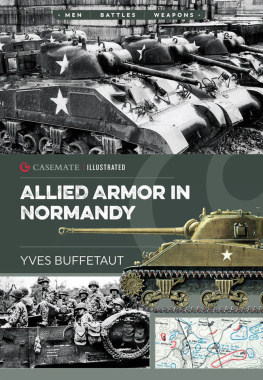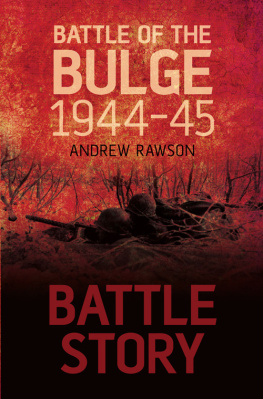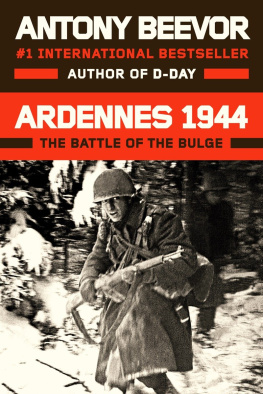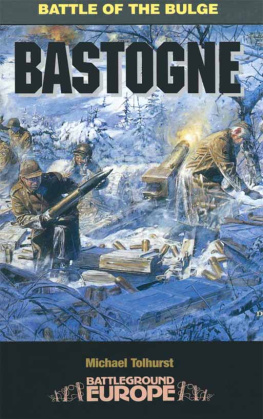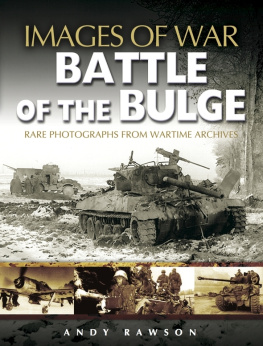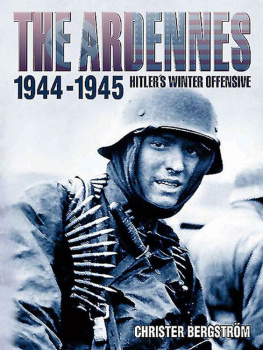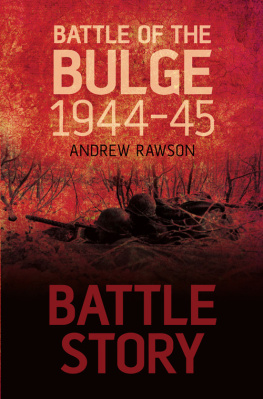Yves Buffetaut - Ardennes 1944: The Battle of the Bulge
Here you can read online Yves Buffetaut - Ardennes 1944: The Battle of the Bulge full text of the book (entire story) in english for free. Download pdf and epub, get meaning, cover and reviews about this ebook. year: 2018, publisher: Casemate, genre: History. Description of the work, (preface) as well as reviews are available. Best literature library LitArk.com created for fans of good reading and offers a wide selection of genres:
Romance novel
Science fiction
Adventure
Detective
Science
History
Home and family
Prose
Art
Politics
Computer
Non-fiction
Religion
Business
Children
Humor
Choose a favorite category and find really read worthwhile books. Enjoy immersion in the world of imagination, feel the emotions of the characters or learn something new for yourself, make an fascinating discovery.
- Book:Ardennes 1944: The Battle of the Bulge
- Author:
- Publisher:Casemate
- Genre:
- Year:2018
- Rating:5 / 5
- Favourites:Add to favourites
- Your mark:
- 100
- 1
- 2
- 3
- 4
- 5
Ardennes 1944: The Battle of the Bulge: summary, description and annotation
We offer to read an annotation, description, summary or preface (depends on what the author of the book "Ardennes 1944: The Battle of the Bulge" wrote himself). If you haven't found the necessary information about the book — write in the comments, we will try to find it.
Ardennes 1944: The Battle of the Bulge — read online for free the complete book (whole text) full work
Below is the text of the book, divided by pages. System saving the place of the last page read, allows you to conveniently read the book "Ardennes 1944: The Battle of the Bulge" online for free, without having to search again every time where you left off. Put a bookmark, and you can go to the page where you finished reading at any time.
Font size:
Interval:
Bookmark:



YVES BUFFETAUT
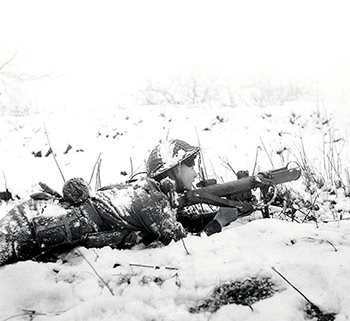

CIS0007
Print Edition: ISBN 978-1-61200-6697
Digital Edition: ISBN 978-1-61200-6703
Kindle Edition: ISBN 978-1-61200-6703
This book is published in cooperation with and under license from Sophia Histoire & Collections. Originally published in French as Militaria Hors-Serie No 93, Histoire & Collections 2013
CASEMATE PUBLISHERS (US)
Telephone (610) 853-9131 Fax (610) 853-9146
Email:
www.casematepublishers.com
CASEMATE PUBLISHERS (UK)
Telephone (01865) 241249 Fax (01865) 794449
Email:
www.casematepublishers.co.uk
Title page: Near Marche-en-Famenne, January 5, 1945, a very youthful PIAT operator in position in a snowy field. He belongs to the 53rd Welsh Division. (IWM B 13394)
Contents page: A typical view of the Battle of the Bulge, with a paratrooper from the 101st Airborne on sentry duty on the edge of Bastogne. (U.S. National Archives)
Map: The German offensive, showing that the 5th Panzer Army made the most significant advances. (Ysec)
Note: vehicle illustrations and profiles are not to scale.
The Ardennes offensive, or the Battle of the Bulge, was fought between December 16, 1944 and January 16, 1945. The German codename for the buildup to the offensive was Wacht am Rhein (Watch on the Rhine), conducted in utmost secrecy, while the offensive proper was codenamed Unternehmen Herbstnebel (Operation Autumn Mist). Repeating the successful blitzkrieg of May 1940, Hitler planned to smash through the Ardennes Forest in a surprise attack, the objective to drive a wedge between the American and British armies in France and the Low Countries and recapture Antwerp in Belgium to deny the Allies use of its port facilities. It was Hitlers last throw of the dice.
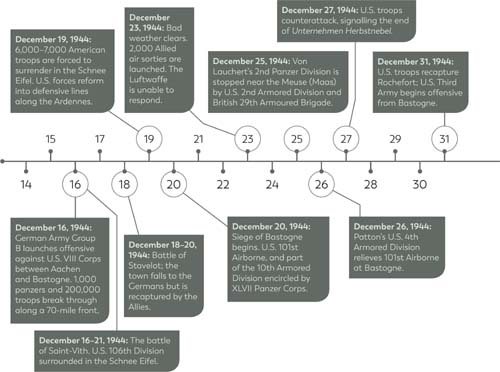
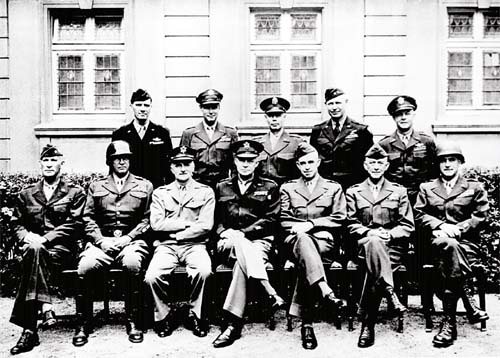
Senior U.S. generals of the Western Front. Front row from left: Simpson, Patton,Spaatz, Eisenhower, Bradley, Hodges, Gerow. Back row from left: Stearley,Vandenberg, Bedell-Smith, Weyland, Nugent. (All rights reserved)
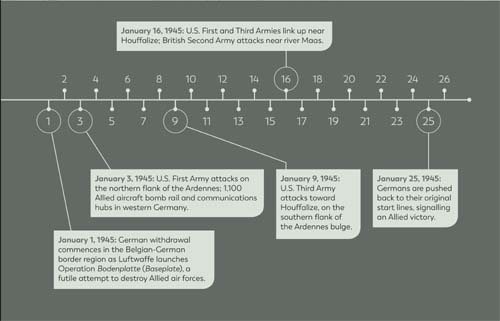
Historians have tended to blame the failure of Operation Wacht am Rhein on the German armys deficiencies toward the end of 1944. It is indeed true that the three armies gathered for the offensive varied wildly in terms of troop strengths and matriel: the 5th Panzer Army was the strongest, but the 6th Panzer Army, while mostly composed of SS divisions, was mediocre, as was the 7th Army. And if gasoline supply was better than what is usually believed, with reserves sufficient to reach at least the Meuse (Maas), the panzer divisions were often not mobile enough, due to a lack of motorized equipment, especially trucks. Similarly, while they had sufficient munitions, many units lacked tanks, self-propelled guns and even artillery.

SS panzergrenadiers in an Ardennes village. A barn is burning, possibly intentionally set on fire by retreating U.S. troops to deny fodder to the Germans. (BA, Bild 183-J28577, Popesch)
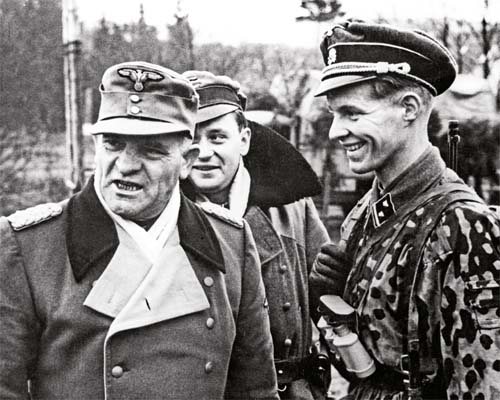
Sepp Dietrich, commanding officer of the 6th Panzer Army, did not believe it was possible to reach Antwerp. To seize Lige would be a victory in itself. (BA, Bild 183-J28625, Roeder)
These weaknesses, inevitable in an army that had been in action for five years, and that had suffered numerous setbacks over the preceding months, cannot be considered the only reasons for the German failure however. It was the speed of the Allied reaction, and especially the U.S.s, that would neutralize the German offensive, even before it could reach the Meuse.
Rather than being yet another blow-by-blow account of Operation Wacht am Rhein and the Allied counteroffensive, this book will describe the various events that brought about the German defeat, from the beginning of the offensive, on December 16, 1944, right through to the German withdrawal behind the Siegfried Line. It will consider the American opposition at Saint-Vith; the 101st Airborne stand at Bastogne; German stubbornness in trying to take Bastogne; the airlift and Ninth U.S. Air Force intervention; the Third U.S. Armys lightning regroup; Pattons counterattack; the British counterattack; and the incomplete Allied victory. The latter reminds us that while the Battle of the Bulge was an undeniable setback for the Germans, the Allies did not press home their advantage and convert it into a telling victory. Unable to maintain the encirclement, they failed to seize the opportunity to cross the Siegfried Line and the Rhine and fix the German armies while they were on the run. However, before considering all of this, we must move back in time to the first day of the offensive, as this was when the most important Allied decisions were made.
What was the aim of this offensive, which was wanted by Hitler and had been planned by the Oberkommando der Wehrmacht (OKW, or High Command of the Armed Forces) and Field Marshal Walter Model, commander of Army Group B? The Fhrer had managedthanks to severe cuts on other frontsto rebuild a strategic army to strike in the West. He planned an attack in the Ardennes, aimed at Antwerp, which would slice through the Allied armies, and encircle most of the British Second and U.S. First Armies before taking this major port city. The port itself was of significant importance to the Allies, as supplies for the front all passed through Antwerp. The offensivekept a secretwas to have two phases: firstly to reach the Meuse, and secondly, capture Antwerp. Field Marshal Wilhelm Keitel, head of Oberkommando des Heeres (OKH, or Army High Command), had stockpiled important fuel reserves west of the Rhine, to assist with the first phase. However, these still had to be delivered to the frontline troops during the operation.
On December 15, 1944, faith in the offensives success among German soldiers on the front line contrasted with the misgivings of the senior commanders. Among the generals,none truly believed they would reach Antwerp. Neither Model, nor Field Marshal Gerd von Rundstedt, Oberbefehlshaber West (OB West), had a detailed operational plan to reduce Antwerp. Their directives stopped on the banks of Meuse. Only General Hasso von Manteuffel, commander of the 5th Panzer Army, gave instructions for the creation of bridgeheads on the opposite bank in case Hitler had other reserves.
Font size:
Interval:
Bookmark:
Similar books «Ardennes 1944: The Battle of the Bulge»
Look at similar books to Ardennes 1944: The Battle of the Bulge. We have selected literature similar in name and meaning in the hope of providing readers with more options to find new, interesting, not yet read works.
Discussion, reviews of the book Ardennes 1944: The Battle of the Bulge and just readers' own opinions. Leave your comments, write what you think about the work, its meaning or the main characters. Specify what exactly you liked and what you didn't like, and why you think so.


